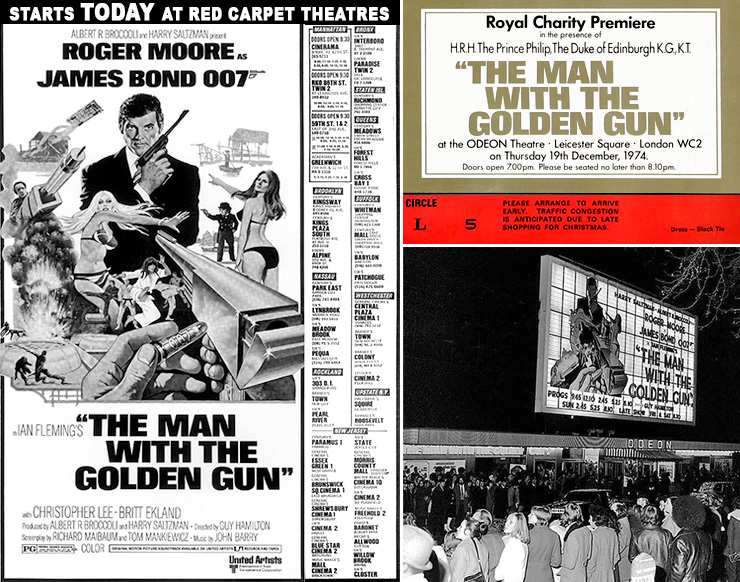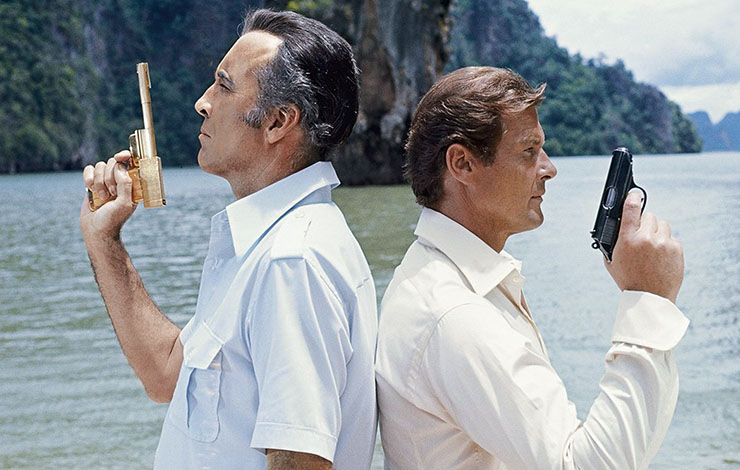|
The
Man With |
||
|
||
|
The
Man With |
||
|
||
 |
|
The Man With The Golden Gun opened at ‘Red Carpet Theatres’ across New York City on Wednesday December 18, 1974, and had its Royal Charity Premiere at London’s ODEON Leicester Square the following evening. Held in the presence of HRH, Prince Philip The Duke of Edinburgh, the event was attended by Roger Moore, Christopher Lee, Britt Ekland, Maud Adams, Hervé Villechaize, Bernard Lee and main title singer Lulu. Producers Harry Saltzman & Albert R. Broccoli put on a brave face for the press photographers; whilst behind-the-scenes their professional relationship was reaching crisis point as pre-production began on The Spy Who Loved Me. Roger Moore’s second James Bond film received less-than-kind reviews in the UK press, with Derek Malcolm in The Guardian saying that “the script is the limpest of the lot and... Roger Moore as 007 is the last man on earth to make it sound better than it is.”, however Malcolm did single out Christopher Lee’s performance for praise. David Robinson, film critic at The Times, dismissed the film and Moore's performance, saying that he was “substituting non-acting for Connery's throwaway”, while Britt Ekland was “his beautiful, idiot side-kick... the least appealing of the Bond heroines”. Robinson noted the changes in production crew, observing that Ken Adam, an “attraction of the early Bond films,” had been “replaced by decorators of competence but little of his flair.” Tom Milne of The Observer was even more scathing and said: “This series, which has been scraping the bottom of the barrel for some time, is now through the bottom … with depressing borrowings from Hong Kong Kung Fu movies, not to mention even more depressing echoes of the ‘Carry On’ smut… sadly lacking in wit or imagination”. With hindsight, most of these comments are fair and reflect the views of many fans and commentators 50 years later. The American press were equally dismissive, although early signs were that United Artists had a hit on their hands, with the film grossing $29.5 million worldwide in its first three weeks of release. However, The Man With The Golden Gun did not have the staying power of earlier entries in the series, and ultimately grossed a total of $97.6 million at the worldwide box office, with $21 million earned in the USA, making it the fourth lowest-grossing Bond film in the series at that time. The Man With The Golden Gun was subsequently re-issued in the UK on double-bills with Live And Let Die (1973) in 1975 and 1978, and again with Moonraker (1979) in July 1980, before making its television debut on the ITV network on Christmas Day that year. |
 |
||||||||||
|
The Man With The Golden Gun (1974) marked a significant turning point for the James Bond film franchise. It was the last film to be co-produced by Harry Saltzman & Albert R. Broccoli, who parted company at the end of 1975 when Saltzman and United Artists finally agreed a deal of $36 million for the producer’s share of DANJAQ. ‘Cubby’ Broccoli was then joined by his stepson Michael G. Wilson, who had helped with many of the legal complications surrounding the split from Harry Saltzman. Broccoli pushed forward with The Spy Who Loved Me (1977), but Guy Hamilton bowed out of the production after being assigned to direct Superman (1978), although he ultimately withdrew from that project too. The spectre of Kevin McClory also appeared on the horizon as the Thunderball producer began to exercise his rights in that property after the initial 10-year legal embargo was over. The Man With The Golden Gun was also the last film of the series to be directly based on a novel by Ian Fleming. All subsequent films up until Casino Royale (2006) had only tenuous links via the title, or were based on elements drawn from Ian Fleming’s short stories. Although The Man With The Golden Gun was far from being a commercial failure, it did consolidate Roger Moore’s popularity with the cinema-going audience, perhaps encouraged by the over reliance on stunts and tongue-in-cheek humour perpetuated by the actor, in collaboration with director Guy Hamilton and screenwriter Tom Mankiewicz. |
||||||||||
|
||||||||||
|
50 years later, The Man With The Golden Gun (1974) can now be regarded as second-tier Bond, with seasoned veterans struggling to come up with anything different from what had gone before. Like all Bond films, the production values and location work in particular stand out, with the Far Eastern settings and use of Khao Ping Kan Island offering something largely unattainable to cinemagoers at the time. Nowadays the Island is a popular tourist hotspot and its connection to The Man With The Golden Gun still celebrated half-a-century later. ‘James Bond Island’ as it is often called, has survived along with Piz Gloria [used extensively in On Her Majesty’s Secret Service (1969)], as two locations that maintain their appeal to this day because of their connection to the world of 007. Christopher Lee’s performance as Scaramanga showed there was far more to the actor than horror roles, and he remains one of the highlights of The Man With The Golden Gun. Maud Adams makes the most of her small role as the doomed Andrea Anders, which no doubt led to her return as the lead in Octopussy (1983) almost a decade later. Britt Ekland, however, fails to rise above the under-written role of the inept and incongruous Swedish MI6 field operative Mary Goodnight, and remains one of the weakest elements in The Man With The Golden Gun. Roger Moore’s involvement in the physical side of the role of James Bond remains impressive – particularly the Kung Fu fight and subsequent river chase, which showed the actor in close-up performing much of the action himself, before the over reliance on stuntmen and rear-projection became a regrettable feature of later films. Although John Barry’s score was rushed (and if we can forgive his use of the slide-whistle!), it is a testament to his enormous talent and undeniable contribution to the Bond series as a whole, that a complete version of his soundtrack for The Man With The Golden Gun was high on the wish list of many fans. To commemorate the 50th Anniversary of The Man With The Golden Gun US boutique label La-La Land Records announced a newly remastered and expanded 2-CD edition of John Barry's soundtrack, alongside that other long-awaited holy grail, Moonraker (1979). The two new special releases make welcome additions to La-La Land's expanding roster of James Bond soundtracks issued in new definitive Limited Editions. |
||||||||||
|
||||||||||
|
Even if The Man With The Golden Gun (1974) failed to live up to the gold standard of Goldfinger (1964) a decade earlier, director Guy Hamilton’s fourth and final James Bond film is far from the worst of the series, and in spite of its relatively underwhelming performance at the box-office marked the end of an era for the franchise. The cinematic landscape changed forever in the mid-1970s, but showed that 007 could still hold his own in the marketplace, and compete with the big American blockbusters that followed in the wake of Jaws (1975) and Star Wars (1977) with directors Steven Spielberg and George Lucas, and a whole generation of ‘movie brats’, later acknowledging their debt to the James Bond films. Fans would have to wait two-and-a-half years for the next instalment when James Bond returned bigger and better than ever, with Producer Albert R. Broccoli overcoming the odds following his split from Harry Saltzman, and showing the industry that “Nobody Does It Better”. |
||||||||||
 |
||||||||||
|
CONTINUED >> |
 |
|||||||||
|
|
||||||||||
|
||||||||||
|
|
||||||||||